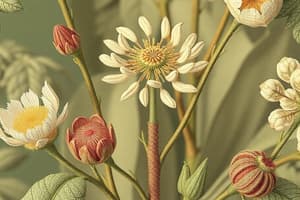Podcast
Questions and Answers
Match the following flower parts with their descriptions:
Match the following flower parts with their descriptions:
Sepals = Enclose and protect the flower before it opens and will sometimes close over the flower at night Petals = Most obvious part of the flower, large, variously shaped and bright to attract pollinators, produce scent to attract insects Stamens = Male part of the plant and consists of anther and filament Carpel = Female part of the plant and consists of stigma, style, and ovary
Match the following flower parts with their functions:
Match the following flower parts with their functions:
Anther = Produces pollen which forms male gametes Stigma = Catches pollen Style = Connects the stigma to the ovary and holds it in a suitable position to collect the pollen Ovary = Has one or more ovules which contain the embryo sac
Match the following flower parts with their associated plant genders:
Match the following flower parts with their associated plant genders:
Stamens = Male part of the plant Carpel = Female part of the plant Sepals = No specific gender Petals = No specific gender
Match the following plant propagation methods with their descriptions:
Match the following plant propagation methods with their descriptions:
Match the following plant propagation methods with their examples:
Match the following plant propagation methods with their examples:
Match the following parts of the plant with their role in propagation:
Match the following parts of the plant with their role in propagation:
Match the following seed dispersal methods with their examples:
Match the following seed dispersal methods with their examples:
Match the following types of asexual reproduction with their examples:
Match the following types of asexual reproduction with their examples:
Match the following stages in germination with their descriptions:
Match the following stages in germination with their descriptions:
Match the following methods of breaking dormancy with their descriptions:
Match the following methods of breaking dormancy with their descriptions:
Match the following parts of a flower with their descriptions:
Match the following parts of a flower with their descriptions:
Match the following terms related to pollination with their definitions:
Match the following terms related to pollination with their definitions:
Match the following terms related to fertilization with their descriptions:
Match the following terms related to fertilization with their descriptions:
Match the following seed structures with their descriptions:
Match the following seed structures with their descriptions:
Flashcards are hidden until you start studying
Study Notes
Plant Reproduction and Development
- Flower parts need to be matched with their descriptions, functions, and associated plant genders.
- Plant propagation methods need to be matched with their descriptions and examples.
- Parts of a plant need to be matched with their role in propagation.
Plant Propagation
- Different methods of plant propagation exist, including asexual reproduction.
- Examples of plant propagation methods need to be recognized.
Seed Dispersal and Germination
- Seed dispersal methods need to be matched with their examples.
- Stages in germination need to be matched with their descriptions.
- Methods of breaking dormancy need to be matched with their descriptions.
Flower Structure and Pollination
- Parts of a flower need to be matched with their descriptions.
- Terms related to pollination need to be matched with their definitions.
Fertilization and Seed Structure
- Terms related to fertilization need to be matched with their descriptions.
- Seed structures need to be matched with their descriptions.
Studying That Suits You
Use AI to generate personalized quizzes and flashcards to suit your learning preferences.




